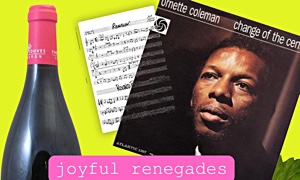Home » Jazz Articles » Jazz & Juice » Spontaneity: Zinfandel Meets The Thad Jones / Mel Lewis Orchestra
Spontaneity: Zinfandel Meets The Thad Jones / Mel Lewis Orchestra
Spontaneity
There's no mistaking music that's truly of and in the moment. Virtuosity, organization, and composition are all to be admired; however, spontaneity and improvisation are big parts of what sets jazz music apart from any other. Having a passion for jazz means relishing spontaneous ideas and what opportunity each moment can bring. Improvised music is the ultimate artistic act of freedom in time.Truly spontaneous music can't be faked—it crackles. It's electric, imperfect, expressive and honest. And when improvisation is underpinned by technique, enhanced by understanding of both instrument and musical form, guided by imagination, greatness is possible.
Great winemaking, like music, requires mastery of technique. "Natural" winemaking, defined broadly, is probably the most wild and improvisational approach to winemaking of all. Done haphazardly, it's oenological anarchy that can create interesting, if less than palatable, results. But when a winemaker understands their materials and how they behave, they can allow the process and the freedom to create something in a class all its own.
The Jazz
 This month's recording brings us to perhaps the most sacred jazz room imaginable: The Village Vanguard. This is the fermentation vessel of the greatest ensembles jazz has ever known—including this group, The Thad Jones-Mel Lewis Orchestra, which has had a standing date on Monday nights ever since this recording was made, in 1966. The band changed in both personnel and name (they are now under the moniker of the Vanguard Jazz Orchestra,) but it keeps the legacy of these two leaders alive to this day.
This month's recording brings us to perhaps the most sacred jazz room imaginable: The Village Vanguard. This is the fermentation vessel of the greatest ensembles jazz has ever known—including this group, The Thad Jones-Mel Lewis Orchestra, which has had a standing date on Monday nights ever since this recording was made, in 1966. The band changed in both personnel and name (they are now under the moniker of the Vanguard Jazz Orchestra,) but it keeps the legacy of these two leaders alive to this day. This month's track is unruly and sophisticated, raucous and revelatory, and utterly in the moment. It's called "Back Bone," and it is the first tune, captured live, from the first set they ever played together on this stage. It is nothing short of thrilling.
One of the things that sets apart Thad and Mel's work is the innovative approach Thad Jones took as an arranger and a kind of composing conductor. We can hear this happening in real time on this track. Using the sturdy blues form as its spine, Thad conducts the orchestra on and away from the chart—in the moment he decides who is soloing, signals the band to drop out, play. spontaneous background lines, encourages humorous cacophony, or signals a return to the written page (there's a lot of vocal exhortations you can hear, many his.) We can hear the music materialize from a place far from any page. It's loose, invigorating and alive.
Thad and Mel's connection to the music, to each other, and to their ensemble is what allows them to teeter just on the edge of chaos and exhilarate us with their daring and joy.
Like Duke Ellington before him, Thad Jones knew, and wrote for, his players. He had the idiosyncrasies and abilities of his players top of mind when he made any musical decision. Many composers across musical idioms compose in an almost platonic way, creating the perfect music in their imaginations, then seeking out those who can play it the way they hope it will sound. Others, like these masters, are able to maintain integrity in their musical ideas while also tailoring the work for the talent they employ. This allows a degree of freedom for the players in which they thrive, especially where improvisation is concerned.
The high level and diversity of the band was another of its strengths. Because the Thad Jones/Mel Lewis Orchestra was never a full-time gig, it was able to utilize a great array of in-demand musicians: young, old, black, white, male, female; cats who were playing in late night TV-show bands and commercial studio work, all there adding their distinctive sound to the mix. The band never paid particularly well—these musicians are in it for the love (and free drinks.)
Now let's connect this idea of tailored technique and embracing the unexpected to our exploration of wine.
The Juice
 If this music could taste like something, it would be the Ambyth Estate Zinfandel 2014 from the Russian River Valley in California. Here we have an incredible example of painstaking technique and also an exuberant celebration of what these grapes improvise on their own.
If this music could taste like something, it would be the Ambyth Estate Zinfandel 2014 from the Russian River Valley in California. Here we have an incredible example of painstaking technique and also an exuberant celebration of what these grapes improvise on their own. This wine right out of the bottle has incredible energy. To start, it offers citric brightness offset by a deep core of liqueur-like fruit. It explodes, settles, and lingers, the concentration of fruit silkily persisting, the tannins wrapping your tongue in brambly texture. It delightfully contradicts itself, and resolves at length. It's exciting, different, powerful, and refreshing, all at the same time.
Spontaneity is embraced by this winemaker through a myriad of techniques, all of which combine to make this wine what might be called natural. Saving complications for future installments, we'll attribute the qualification of this wine as natural to how carefully the vineyard and winery are managed as a whole so that the fruit, and the wine, is freer to do its own thing.
Our focus today is fermentation: when the sugars in a grape convert to alcohol. Yeast is the single celled fungi that makes it happen. It's common, and sometimes advisable, to use yeast that's been inoculated (or rather, made in a lab) in order to optimize the process and the product of fermentation. It allows for control and precision—like fully notated sheet music.
AmByth's wine, however, is spontaneously fermented, meaning the juice grabs yeast from its surroundings—the air, equipment, the grapes themselves— to transform juice into wine. Done in this way, there's usually a diverse array of yeasts that participate as opposed to only one that dominates. This contributes to the depth of flavor and intrigue this wine offers.
Spontaneous fermentation is a risky proposition without intimate familiarity with one's grapes, farm, and environment. Just as with music, knowledge, technique, and vision are what makes freedom sing.
What's Next
Our discussion continues in next week's video when I'll talk about texture, both in this wine and in the arrangements of the Thad Jones/Mel Lewis Orchestra.Do you have questions about fermentation? What are your favorite wild, live recordings? I'd love to hear from you in the comments here or directly to me contact me, with Jazz & Juice in the subject. Perhaps you'll inspire something I'll include in next week's video and the following podcast!
Tags
About The Thad Jones-Mel Lewis Orchestra
Instrument: Band / ensemble / orchestra
PREVIOUS / NEXT
Support All About Jazz
 All About Jazz has been a pillar of jazz since 1995, championing it as an art form and, more importantly, supporting the musicians who make it. Our enduring commitment has made "AAJ" one of the most culturally important websites of its kind, read by hundreds of thousands of fans, musicians and industry figures every month.
All About Jazz has been a pillar of jazz since 1995, championing it as an art form and, more importantly, supporting the musicians who make it. Our enduring commitment has made "AAJ" one of the most culturally important websites of its kind, read by hundreds of thousands of fans, musicians and industry figures every month.






















